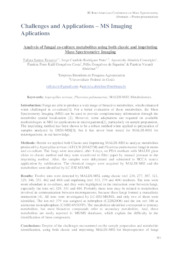Analysis of fungal co-culture metabolites using both classic and imprinting Mass Spectrometry Imaging.
Analysis of fungal co-culture metabolites using both classic and imprinting Mass Spectrometry Imaging.
Author(s): TEIXEIRA, T. S.; RODRIGUES NETO, J. C.; CONCEIÇÃO, A. A.; COSTA, P. P. K. G.; SIQUEIRA, F. G. de; ABDELNUR, P. V.
Summary: Fungi are able to produce a wide range of bioactive metabolites, which enhanced when challenged in co-culture[1]. For a better evaluation of these metabolites, the Mass Spectrometry Imaging (MSI) can be used to provide complementary information through the metabolite spatial localization [2]. However, some adaptations are required on available methodologies in MSI for applications in microrganisms[2], particularly on sample preparation. The imprinting method has been shown to be a robust method when applied to preparation of samples analyzed by DESI-MSI[3], but it has never been tested for MALDI-MSI for microrganisms, in our knowledge.
Publication year: 2022
Types of publication: Abstract in annals or event proceedings
Unit: Embrapa Agroenergy
Keywords: Aspergillus terreus, MALDI-MSI, Metabolomics, Pleorotus pulmonarius
Observation
Some of Embrapa's publications are published as ePub files. To read them, use or download one of the following free software options to your computer or mobile device. Android: Google Play Books; IOS: iBooks; Windows and Linux: Calibre.
Access other publications
Access the Agricultural Research Database (BDPA) to consult Embrapa's full library collection and records.
Visit Embrapa Bookstore to purchase books and other publications sold by Embrapa.

